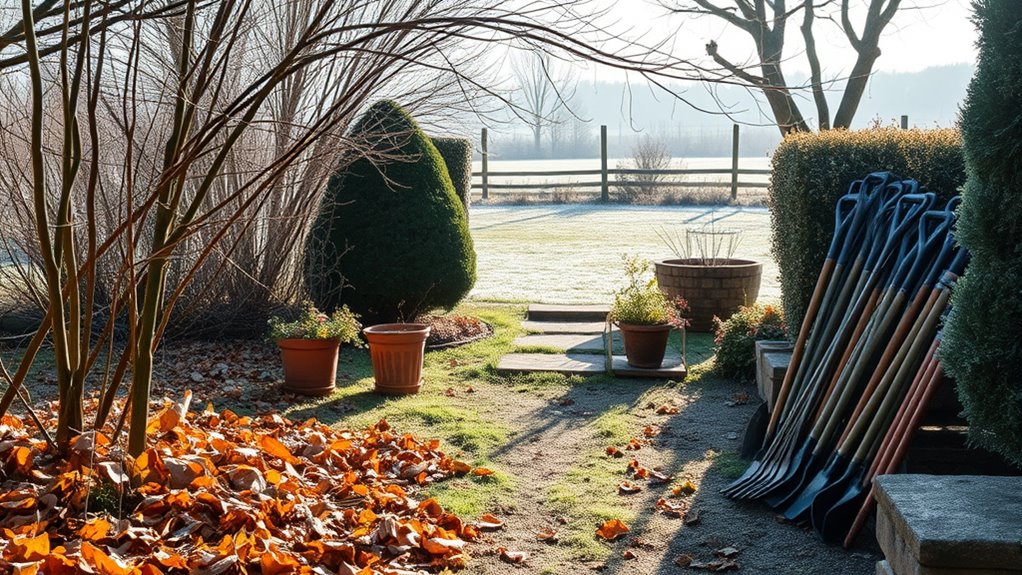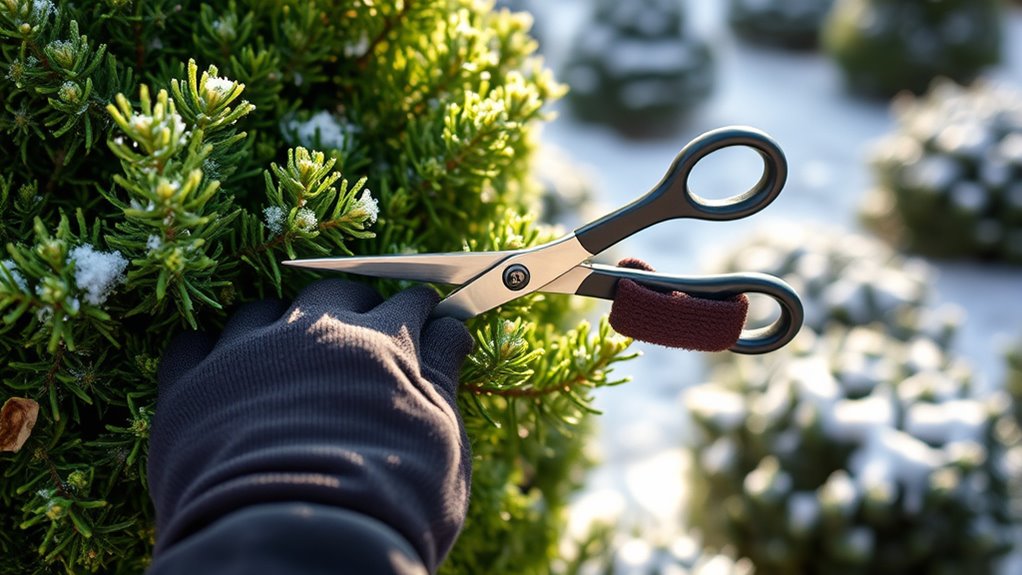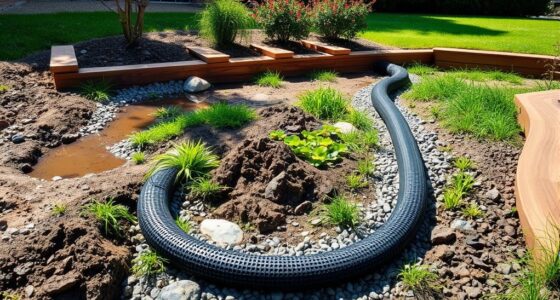To winterize your garden easily, start by clearing out dead plants, fallen leaves, and debris to prevent pests and disease. Protect sensitive shrubs with burlap or covers, and mulch around roots to insulate soil. Prune damaged branches and cover exposed areas with frost blankets or plastic. Water plants thoroughly before deep freezes and prepare your soil with compost and amendments for next season. Organize your tools and add cozy touches—if you keep going, you’ll discover more helpful tricks.
Key Takeaways
- Remove dead plants, debris, and clutter to prevent pests and diseases.
- Protect sensitive plants with burlap wraps or frost blankets, securing them properly.
- Mulch around plants with straw or wood chips to insulate roots and retain moisture.
- Prune damaged branches after last growth and before severe cold to promote health.
- Store garden tools and décor indoors, and enhance outdoor space with lighting for winter appeal.
Clearing and Cleaning Your Garden Space

Before winter arrives, it’s essential to clear out your garden to prevent disease and prepare the space for next season. Start by removing dead plants, fallen leaves, and debris that can harbor pests and fungi. Sweep and tidy your garden décor, like garden statues or furniture, so they’re clean and ready for storage. Clearing clutter reduces hiding spots for pests and makes your garden look neat. Check your tools and dispose of any diseased plant material properly. This cleanup enhances pest control by eliminating attractants and potential breeding grounds. Additionally, removing garden debris helps prevent the accumulation of moisture that can lead to mold or rot. Plus, a tidy garden provides a blank canvas for spring décor and planting. Taking these steps now guarantees your garden stays healthy through winter and is ready to flourish when warmer weather returns.
Protecting Sensitive Plants and Shrubs

As winter approaches, it’s essential to protect your sensitive plants and shrubs from cold damage. Start by applying seasonal fertilization to boost their resilience and guarantee they have enough nutrients to withstand harsh conditions. Stronger plants are better equipped to handle winter stress. Additionally, take steps for pest prevention, as some pests seek shelter during the cold months and can damage your plants. Remove any fallen leaves or debris that might harbor pests or disease. Consider wrapping vulnerable shrubs with burlap or protective covers to shield them from freezing winds. Water your plants thoroughly before a deep freeze, as moist soil helps insulate roots. Moreover, understanding payment security vulnerabilities can help you implement better safeguards for your garden’s infrastructure, ensuring your investments are protected. By combining proper fertilization with pest prevention measures, you give your sensitive plants the best chance to survive winter intact.
Mulching to Insulate and Nourish

Have you considered how mulching can protect your garden during winter? Mulch types like straw, wood chips, or shredded leaves create an insulating layer that shields roots from freezing temperatures. Proper mulch application involves spreading a 2-3 inch layer around your plants, ensuring you keep it a few inches away from the stems to prevent rot. Mulching helps retain soil moisture, reducing the need for watering during cold months. It also adds nutrients as it decomposes, nourishing your plants naturally. Choose mulch based on your garden’s needs and your local climate. By applying mulch correctly, you create a protective barrier that insulates roots and promotes healthy growth come spring. This simple step can make a significant difference in winter garden survival.
Pruning and Cutting Back for Healthy Growth

Pruning and cutting back your plants now promotes healthy growth and prepares them for winter. Use proper pruning techniques to remove dead or damaged branches, which helps prevent disease and encourages new growth in spring. Always select sharp cutting tools to make clean cuts, minimizing stress on your plants. For shrubs and perennials, prune back by about one-third, focusing on shaping and removing weak growth. Avoid heavy pruning on certain species, so research each plant’s needs. Timing is vital; prune after the last flush of growth but before severe cold sets in. This routine not only enhances the plant’s structure but also boosts resilience through winter. Proper pruning now ensures your garden remains vigorous and healthy when warmer weather returns. Regularly inspecting and adjusting your practices helps maintain optimal garden health and aligns with best practices for plant care.
Covering Your Garden With Protective Materials

To safeguard your garden this winter, you’ll need to select the right covers that suit your plants. Applying mulch effectively helps insulate roots, while securing your coverings guarantees they stay in place during storms. Properly managing these steps will give your garden the best chance to survive the cold months. Using self-watering planters can also reduce the need for frequent watering during the winter months, helping maintain consistent moisture levels for your plants.
Choosing Suitable Covers
Choosing the right covers is essential for protecting your garden from winter damage. You need materials that provide effective frost protection and act as wind barriers. Clear plastic or frost blankets are great for trapping heat and shielding plants from freezing temperatures. These covers allow sunlight to reach your plants while preventing frost from forming. For added wind protection, consider using burlap, row covers, or sturdy fabric that can block chilly gusts. Ensure covers are not tightly sealed, so moisture can escape and prevent mold growth. Properly securing the edges prevents cold air and wind from seeping in. Selecting covers suited for your specific plants and local climate makes winterizing easier and more effective, giving your garden the best chance to survive harsh weather. Additionally, smart environmental controls can automatically adjust coverage or heating to optimize protection and energy use.
Applying Mulch Effectively
Applying mulch effectively is a key step in winterizing your garden, as it helps insulate roots and retain soil warmth. Use layering techniques to ensure proper coverage, starting with a thin base layer and adding more if needed. Choose mulch types like straw, wood chips, or shredded leaves, depending on your plants and climate. Spread mulch evenly around plants, keeping it a few inches away from stems to prevent rot. This creates a protective barrier that shields roots from freezing temperatures. Proper layering ensures better insulation and moisture retention. Remember, too thick a layer can trap moisture and cause issues, so aim for 2-4 inches of mulch. Below is a quick guide to help you select and apply mulch effectively:
| Mulch Type | Layering Technique | Best Use |
|---|---|---|
| Straw | Light, even layer | Vegetable beds |
| Wood Chips | 3-4 inches thick | Perennials, shrubs |
| Shredded Leaves | Layer as needed | General garden coverage |
| Compost | Thin, 1-2 inches | Soil enrichment |
| Bark Mulch | 2-3 inches thick | Flower beds, trees |
Securing Coverings Properly
Securing coverings properly is essential for preventing damage from snow, wind, and freezing temperatures. If you’re using protective materials like blankets, row covers, or plastic sheeting, make sure they’re anchored tightly to avoid flapping or blowing away. Use stakes, bricks, or weights to keep edges secure. Be cautious around your drip irrigation system—cover or disconnect it to prevent freezing or leaks. Properly secured coverings also help with pest control, keeping pests out while maintaining insulation. Check that all seams are sealed and that coverings don’t sag or create gaps where cold air can enter. Regularly inspect your setup throughout winter storms to ensure everything stays in place. Well-secured coverings protect your garden’s roots and plants, making winterization more effective and stress-free. Additionally, attention to detail during setup can significantly improve the longevity and effectiveness of your winter protection measures.
Preparing Soil for Next Season

As winter approaches, it’s essential to prepare your soil for the upcoming growing season. Start by testing your soil to identify deficiencies and pH levels, ensuring you make targeted adjustments. Incorporate compost addition to enrich the soil with organic matter, improve drainage, and boost nutrients. To get your soil ready, consider these steps:
- Conduct soil testing to determine nutrient needs
- Add compost to enhance fertility and structure
- Loosen compacted soil for better aeration
- Remove weeds and debris to prevent pests and diseases
- Pay attention to color accuracy in your soil amendments to ensure even nutrient distribution and healthy plant growth.
Taking these steps now will set a strong foundation for healthy plants next season. Properly prepared soil not only promotes vigorous growth but also reduces the need for chemical fertilizers later on. It’s a simple, effective way to winterize your garden soil.
Organizing Tools and Final Touches

Once you’ve prepared your soil, organizing your gardening tools and adding final touches guarantees a smooth progression into winter. Start by cleaning and storing tools properly to extend their lifespan. Group similar tools together, and consider labeling containers for easy access next season. As you tidy up, incorporate garden decor and outdoor lighting to enhance your space’s winter appeal and safety. Store decorative items indoors or in a protected area, and check outdoor lights to verify they’re functioning correctly. A well-organized garden not only simplifies spring preparations but also gives your yard a polished look during the colder months. Final touches like strategic lighting create a cozy ambiance, while weatherproof decor adds charm. These steps make winterizing efficient and guarantee your garden stays inviting year-round.
Frequently Asked Questions
When Is the Best Time to Start Winterizing My Garden?
The best time to start winterizing your garden depends on your location and seasonal planning. Generally, you should begin when temperatures consistently stay below 50°F at night, signaling it’s time to protect your plants. Timing considerations are key, so monitor local weather forecasts. Starting too early can stress plants, while waiting too long risks damage. Aim for a window when weather is stable and cooling gradually, ensuring your garden’s health through winter.
How Can I Prevent Pests From Overwintering in My Garden?
To prevent pests from overwintering, you should start with companion planting, which naturally repels pests by attracting beneficial insects. Use natural repellents like neem oil or garlic spray to deter pests effectively. Remove plant debris and mulch where pests hide, and prune affected plants. These steps reduce pest habitats, making your garden less inviting for overwintering pests and helping keep it pest-free come spring.
Are There Any Plants That Shouldn’T Be Covered During Winter?
You should avoid covering tender perennials and delicate succulents during winter, as their sensitive tissues can trap moisture and cause rot. These plants thrive in mild conditions and may suffer if wrapped up in heavy coverings. Instead, provide insulation with mulch or move potted plants indoors. Protecting only hardy plants guarantees your garden remains healthy, while tender and delicate species get the care they need during colder months.
What Are Eco-Friendly Alternatives to Traditional Mulching Materials?
You’re looking for eco-friendly alternatives to traditional mulching materials. Consider using compost mulching, which enriches your soil while protecting plants. Biodegradable covers made from natural fibers also work well—they break down over time, reducing waste. These options help you maintain a healthy garden without harming the environment, making your winterizing efforts both effective and sustainable. Plus, they support soil health and promote plant resilience during colder months.
How Do I Know if My Garden Needs Extra Protection During a Mild Winter?
To know if your garden needs extra protection during a mild winter, look for signs like exposed roots, sensitive plants, or areas prone to frost risk. Check your garden insulation, especially in low-lying or wind-exposed spots, and monitor weather forecasts. If frosty nights are expected or if plants seem vulnerable, give them extra care. Remember, even mild winters can surprise you, so stay vigilant and protect your garden accordingly.
Conclusion
As you finish winterizing your garden, imagine it wrapped in a cozy blanket, ready to rest until spring’s gentle awakening. Your careful steps have shielded delicate plants, nourished the soil, and tidied your space like a painter’s final brushstroke. With your tools organized and your garden protected, you’ve set the stage for a vibrant comeback. Rest easy knowing your garden’s dreams are safely tucked in, waiting patiently for the sun’s warm embrace to bloom again.









